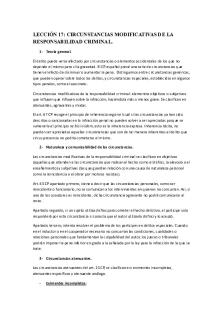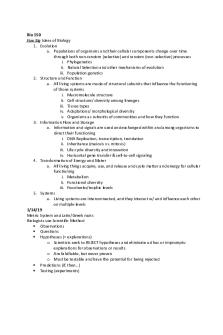ARTS 150 Lecture 17 PDF

| Title | ARTS 150 Lecture 17 |
|---|---|
| Course | Art History Survey II |
| Institution | Texas A&M University |
| Pages | 4 |
| File Size | 137.8 KB |
| File Type | |
| Total Downloads | 60 |
| Total Views | 172 |
Summary
Campana Lecture 17 Captions...
Description
Dr. Lilia Campana
ARTS 150
Spring 2018
Lecture 17
Slide 01 – Good morning everybody and welcome to lecture 17 of Art History Survey Part Two. Slide 02 – The topic of today is the International Scene since 1950: which corresponds to Chapter number 33 from page 1982 to page 1137 of your textbook. Slide 03 – Here is the outline for Chapter 33. And because it is quite a long chapter and this is our last lecture; and I know that you have an exam coming soon, I made a selection of the topics to present to you today. We will start with an historic background: 1. The World since the 1950s 2. The Expanding Art World a. Then we are going to see Pop Art: in particular Andy Warhol 3. The Dematerialization of the Art Object a. Then we are going to see Feminist and Art: in particular Judy Chicago 4. Architecture: Mid-Century Modernism to Post-Modernism a. Mid-Century Modernist Architecture b. Post-modern Architecture 5. And finally we are going to end the lecture with Postmodernism a. And we are going to talk a bit about Jean-Michel Basquiat Slide 04 – Today there is only one keyword to learn and it is:
Silkscreen
I remind you that these words are in bold in your textbook. As you read your textbook, learn all the words that in bold. You can find a Glossary at the end of your textbook (pages 1138-1146) where they are listed and explained. Slide 05 – So this is going to be a very short lecture just to allow you to study better for your exam. But let’s start with our first section: The World since the 1950s. And you have a map at the center of your slide with Europe, Africa and North America. The Unites States and the Soviet Union emerged from World War II (1939-1945) as the world’s most powerful nations. The Soviet occupation and sponsorship of communist governments in several Central and Eastern European states, and the emergence of the People’s Republic of China in 1949 compelled the United States to attempt to contain further expansion of Soviet power and communism into American spheres of influence, particularly in Western Europe.
Dr. Lilia Campana
ARTS 150
Spring 2018
Slide 06 – Now let’s see Pop Art, and in particular the very famous Andy Warhol. The generation of artists who began to make art in the 1950s increasingly addressed the real world, acknowledging its fragmentation, its relativism, and its messy relation to popular culture. Pop art originated in Britain, but its primary development was in the United States during the early 1960s, at a time when individual and mass identity was increasingly determined by how people looked and dressed, as well as by what they displayed and consumed. By 1960, several American artists began to incorporate images from popular mass culture into their art. As Pop Art flourished in the United States, Andy Warhol (1928-1987) emerged as a dominant figure. In 1964, in his sculptural project, Warhol hired carpenters to create plywood boxes identical in size and shape to the cardboard used to ship boxes of Brillo soap pads to supermarkets. By silkscreening onto these boxes the logos and texts that appeared on the actual cartons, the artists created what were essentially useless replicas of commercial packaging. Silk-screen is an industrial print method in which paint or ink is pressed through a stencil and specially cloth to reproduce a design in multiple copies. If you click on the icon at the bottom of your slide, you can enjoy a video on how to make a silkscreen. Slide 07 –In 1962, the movie star Marilyn Monroe died suddenly, an apparent suicide. Warhol’s Marilyn Diptych (which you can see here) is one of a series of silk-screens that Warhol made immediately after the actress’ death. Warhol memorializes the screen image of Monroe, using a famous publicity photograph transferred directly onto silk-screen, thus rendering it flat and bland so that Monroe’s signature features – her bleach-blond hair, her ruby lips, and her sultry blue-shadowed eye – stand out as a caricature of the actress. Now if you click on the icon at the bottom of your slide, you can have a closer look at Andy Warhol’s Diptych. Slide 08 – Now let’s leave Pop Art, and let’s discuss Feminist Art; and in particular Judy Chicago. The idea of feminist art developed alongside the women’s liberation movement of the 1960s as a challenge to one of the major unspoken conventions of art history: that great art could only be made by men.
Dr. Lilia Campana
ARTS 150
Spring 2018
Born Judy Cohen, Judy Chicago (she was born in1939) adopted the name of the city of her birth. Her most famous creation is The Dinner Party (which you can see here at your left), one of the largest and best-known feminist artworks of the 1970s. The Dinner Party is a large, complex, mixed-media installation dedicated to hundreds of women and women artists rescued from anonymity by early women artists and historians. Each larger-than-life place setting includes a 14-inch-wide painted porcelain plate, ceramic flatware, a ceramic chalice with a gold interior, and an embroidered napkin. And each seat is dedicated to a women or a women artist. It is quite an interesting artwork. Now if you click on the icon at the bottom of your slide, you can enjoy have a closer look at Judy Chicago’s The Dinner Party. Slide 09 – Now let’s move on with Mid-century Modernist Architecture Mid-century Modernism in architecture is characterized by plainly visible structure and the rejection of historicism. The style is plain and simple, combining geometric figures and completely lacking any decoration. Frank Lloyd Wright (who we have met in the last lecture) transformed museum architecture with the Solomon R. Guggenheim Museum in New York, designed as a sculptural work of art in its own right. The museum was built to house the very famous art collection of Solomon Guggenheim. The design took a spiral form and the museum is one of the twentieth century’s most distinctive museums spaces. The museum is one 20th century most distinctive museum spaces in the world. Slide 10 – Postmodern Architecture began to appear in the 1970s, and it is characterized by their introduction of the past styles into modern design; it is a combination of old and new, modern and old styles. The Vanna Venturi House, which was designed by architect Robert Venturi for his mother, has a façade that displays features of Western houses, even though the house shows triangles and squares which were typical of Modernism. So in this house Venturi combined Western Style/Old Western Style, with the features of Modern/ Postmodern architecture. Slide 11 – One of the most famous artists of the Postmodern period is Jean-Michel Basquiat (1960-1988), who died from a heroin overdose at a very young age of 27.
Dr. Lilia Campana
ARTS 150
Spring 2018
The strongly emotional Horn Players of 1983 portrays legendary jazz musicians Charlie Parker (upper left) and Dizzy Gillespie (center right) using urgent paint application and hurried lettering to convey Basquiat’s dedication to jazz and his passionate determination to foreground AfricanAmerican subjects in an unsentimental way. Slide 12 – THANK YOU!...
Similar Free PDFs

ARTS 150 Lecture 17
- 4 Pages

ARTS 150 Lecture 7
- 7 Pages

LecciÓn 17 - Lecture notes 17
- 6 Pages

Chapter 17 - Lecture notes 17
- 15 Pages

Chapter 17 - Lecture notes 17
- 7 Pages

Bio 150 - Lecture notes 1-7
- 5 Pages

2020-BIO 150-lecture notes 3
- 1 Pages

Lecture 14-17 Transplantation
- 15 Pages

LEC17 - Lecture notes 17
- 28 Pages

Lecture 17 - Dr. Chard
- 3 Pages

Lecture 17- Child Protection
- 11 Pages

CH17 - Lecture notes 17
- 17 Pages
Popular Institutions
- Tinajero National High School - Annex
- Politeknik Caltex Riau
- Yokohama City University
- SGT University
- University of Al-Qadisiyah
- Divine Word College of Vigan
- Techniek College Rotterdam
- Universidade de Santiago
- Universiti Teknologi MARA Cawangan Johor Kampus Pasir Gudang
- Poltekkes Kemenkes Yogyakarta
- Baguio City National High School
- Colegio san marcos
- preparatoria uno
- Centro de Bachillerato Tecnológico Industrial y de Servicios No. 107
- Dalian Maritime University
- Quang Trung Secondary School
- Colegio Tecnológico en Informática
- Corporación Regional de Educación Superior
- Grupo CEDVA
- Dar Al Uloom University
- Centro de Estudios Preuniversitarios de la Universidad Nacional de Ingeniería
- 上智大学
- Aakash International School, Nuna Majara
- San Felipe Neri Catholic School
- Kang Chiao International School - New Taipei City
- Misamis Occidental National High School
- Institución Educativa Escuela Normal Juan Ladrilleros
- Kolehiyo ng Pantukan
- Batanes State College
- Instituto Continental
- Sekolah Menengah Kejuruan Kesehatan Kaltara (Tarakan)
- Colegio de La Inmaculada Concepcion - Cebu



